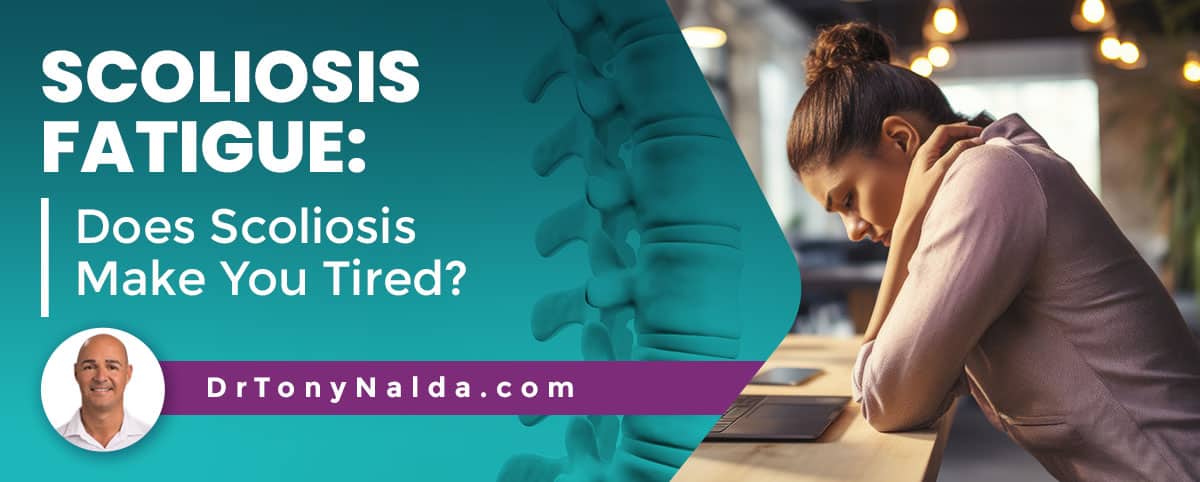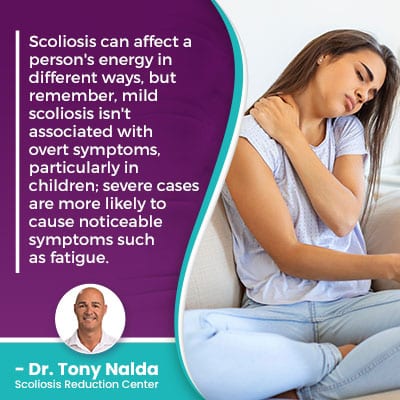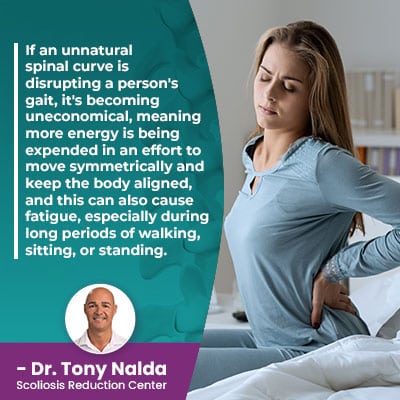Scoliosis Fatigue: Does Scoliosis Make You Tired?

Scoliosis is a structural spinal condition that's progressive in nature, meaning it's virtually guaranteed to get worse over time. When it comes to scoliosis fatigue, we're talking about extra energy expended in an effort to maintain an economical gait, and adjusting to the unnatural spinal curve's presence can be tiring for the body.
Although scoliosis is a spinal condition, its effects aren't just isolated to the back. Scoliosis can cause a wide range of symptoms, including postural changes and fatigue. Scoliosis can also disrupt sleep by making it difficult to get comfortable, and for adults, because of pain.
Scoliosis can affect the body in a number of ways, so let's start with some of the main symptoms associated with the condition.
Table of Contents
Understanding Scoliosis
Scoliosis is the development of an unnatural sideways spinal curve, and a scoliotic curve doesn't just bend unnaturally to the side, but also twists, making it a 3-dimensional condition.
As the spine gives the body structure, protects important organs, allows us to stand upright, practice good posture, balance, and move flexibly, spinal conditions can cause a number of symptoms.
In addition, the spinal cord within works in tandem with the brain to form the central nervous system (CNS), so the spine is involved in the function of virtually every system at work within the body.
As an unnatural spinal curve develops, it introduces a lot of uneven forces to the body, and scoliosis can range widely in severity from mild to moderate and severe to very severe, and as a progressive condition, where a scoliosis is at the time of diagnosis isn't always indicative of where it will stay.
While we don't always know what triggers the initial onset of scoliosis, we do know what triggers its progression: growth and development.
The more severe scoliosis gets, the more noticeable its symptoms are likely to be, and common symptoms of scoliosis depend on a number of patient/condition variables: patient age, condition type, severity, and curvature location.
Different Types of Scoliosis
Part of diagnosing scoliosis involves comprehensively assessing conditions so they can be further classified based on important variables, one of which is condition type.
Condition type is determined by its underlying cause.
The most common type of scoliosis to affect all ages is idiopathic scoliosis, meaning not clearly associated with a single-known cause, with adolescent idiopathic scoliosis (AIS), diagnosed between the ages of 10 and 18, as the most prevalent type overall.
Approximately 80 percent of known diagnosed scoliosis cases are classified as idiopathic scoliosis, and the remaining 20 percent are associated with known causes: neuromuscular scoliosis, degenerative scoliosis, and congenital scoliosis.
Cases of neuromuscular scoliosis are caused by the presence of a larger neuromuscular condition such as cerebral palsy, muscular dystrophy, and spina bifida.
Degenerative scoliosis is caused by natural age-related spinal degeneration, and congenital scoliosis is a rare form that's caused by a malformed spine that develops in utero.
When an abnormal curvature of the spine develops, it can cause a number of symptoms, so let's start with the main symptoms of scoliosis in children and adults.
Scoliosis Symptoms
Each case of scoliosis is unique; the complex nature of scoliosis necessitates a customized scoliosis treatment approach.
In children, the most common symptom of scoliosis is postural deviation, and this is caused by the condition's uneven forces disrupting the body's overall symmetry.
The earliest signs of scoliosis in children are often uneven shoulders and hips, with one hip sitting higher than the other, and other symptoms related to postural changes can include:
- The head uncentered over the torso
- An uneven eye line
- Uneven shoulder blades
- The development of a rib arch
- One leg appearing longer than the other
- One arm appearing longer than the other
In addition, changes to balance, coordination, and gait are also common as the body's center of gravity shifts.
In adults, the main symptom of scoliosis is pain. Scoliosis doesn't become a compressive condition until skeletal maturity has been reached, which is why back pain isn't always part scoliosis in children.
In young patients whose spines are still growing, the constant lengthening motion is counteracting the compressive force of the unnatural spinal curve, and it's compression of the spine and its surrounding muscles and nerves that causes the majority of condition-related pain.
In adult scoliosis, it's common that these patients had it during adolescence, but were neither diagnosed nor treated at the time, so the scoliosis progressed with time and maturity into adulthood, and when it became compressive, it started to cause noticeable symptoms like pain.
 Now, what about tiredness and lethargy? Is scoliosis associated with excessive fatigue?
Now, what about tiredness and lethargy? Is scoliosis associated with excessive fatigue?
Scoliosis Fatigue
For those asking can scoliosis make you tired? Yes, it can, although just because some people experience noticeable changes to their energy level doesn't guarantee others will.
Scoliosis can affect a person's energy in different ways, and remember, mild scoliosis isn't associated with overt symptoms, particularly in children; severe cases are more likely to cause noticeable symptoms such as fatigue.
One way scoliosis can cause fatigue is related to the postural changes it causes; the shift in the body's center of gravity, balance, and coordination change a person's postural balance and gait.
Uneven hips are a symptom of scoliosis, and the way the pelvis and hips rotate during movement determines a person's gait.
Having an aligned spine is the best way to keep the body aligned as this helps with balance, posture, and gait.
If an unnatural spinal curve is disrupting a person's gait, it's becoming uneconomical, meaning more energy is being expended in an effort to move symmetrically and keep the body aligned, and this can also cause fatigue, especially during long periods of walking, sitting, or standing.
For patients experiencing scoliosis pain, this can involve muscle spasms and pain, localized back pain, leg pain, chest pain, and pain that radiates into the extremities, and scoliosis patients can experience pain that ranges from mild and intermittent to chronic and debilitating.
The more constant the pain is, the more likely it is to be tiring; chronic pain is associated with chronic fatigue.
 In addition to postural changes and pain causing fatigue, what about sleep? Do scoliosis patients find it difficult to get a good night's sleep?
In addition to postural changes and pain causing fatigue, what about sleep? Do scoliosis patients find it difficult to get a good night's sleep?
Scoliosis and Sleep
Scoliosis can make it difficult to get a good night's sleep, particularly when severe and/or if left untreated.
For those experiencing postural deviation, it can feel like the body is being pulled to one side, and this can make it difficult to settle into a comfortable sleeping position at night.
The best sleeping positions for scoliosis are those that keep the spine aligned and in a neutral position: flat on the back, then side sleeping, and the worst position is stomach-sleeping.
For those finding it difficult to get comfortable at night, choosing the best sleep position, mattress, and pillow for scoliosis can help.
For those with severe scoliosis, lung impairment can become an issue if the unnatural spinal curve progresses to the point of causing a rib arch, as this can encroach on the space used for the lungs to function optimally within.
When there is less space for the lungs to function within, it can be difficult to fully inhale/exhale, and this can make it difficult to settle into a rhythmic breathing pattern during sleep.
Another factor to consider is treatment; treatment can be intense and involve chiropractic care, physical therapy, corrective bracing, and rehabilitation.
The rigors of treatment can also cause a lot of fatigue and exhaustion as it involves constantly working to counteract the condition's progressive nature, particularly in children for whom growth spurts can trigger rapid-phase progression.
Conclusion
So does scoliosis make you tired: it most certainly can, but isn't guaranteed to do so.
Scoliosis ranges widely in severity from mild to moderate and severe to very severe, so symptoms one patient experiences aren't always indicative of what others will face.
As an unnatural sideways spinal curve that also rotates, scoliosis can cause a number of symptoms felt throughout the body, including fatigue.
Scoliosis fatigue can be the result of trying to keep the body and spine aligned, an uneconomical gait, pain, sleep troubles, and the rigors of intense treatment.
Here at the Scoliosis Reduction Center, I carefully monitor how the spine is responding to treatment through x rays, and part of my treatment focus is to minimize condition-effects, like fatigue, by working proactively to prevent progression; as a progressive condition, it's far simpler to proactively work towards preventing increasing condition-effects, than it is to attempt to reverse them once they've developed.
Dr. Tony Nalda
DOCTOR OF CHIROPRACTIC
After receiving an undergraduate degree in psychology and his Doctorate of Chiropractic from Life University, Dr. Nalda settled in Celebration, Florida and proceeded to build one of Central Florida’s most successful chiropractic clinics.
His experience with patients suffering from scoliosis, and the confusion and frustration they faced, led him to seek a specialty in scoliosis care. In 2006 he completed his Intensive Care Certification from CLEAR Institute, a leading scoliosis educational and certification center.
About Dr. Tony Nalda
 Ready to explore scoliosis treatment? Contact Us Now
Ready to explore scoliosis treatment? Contact Us Now





